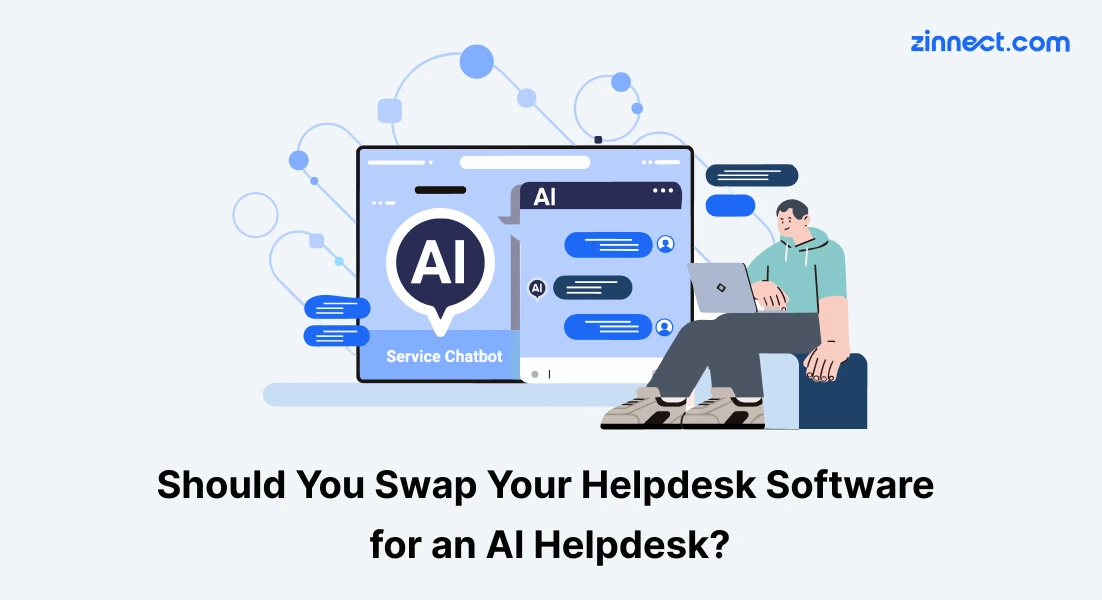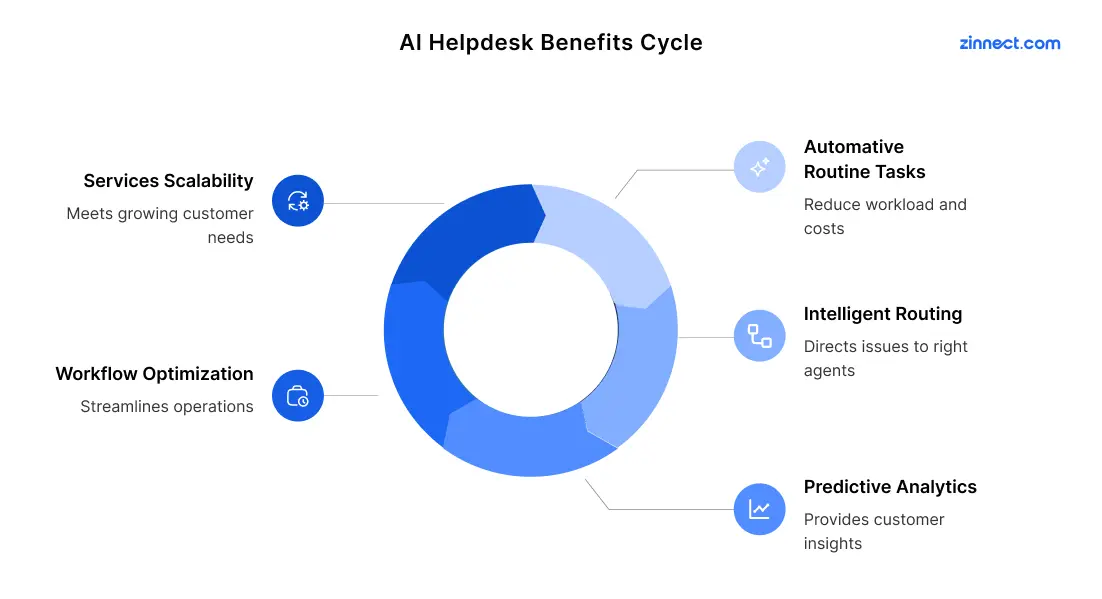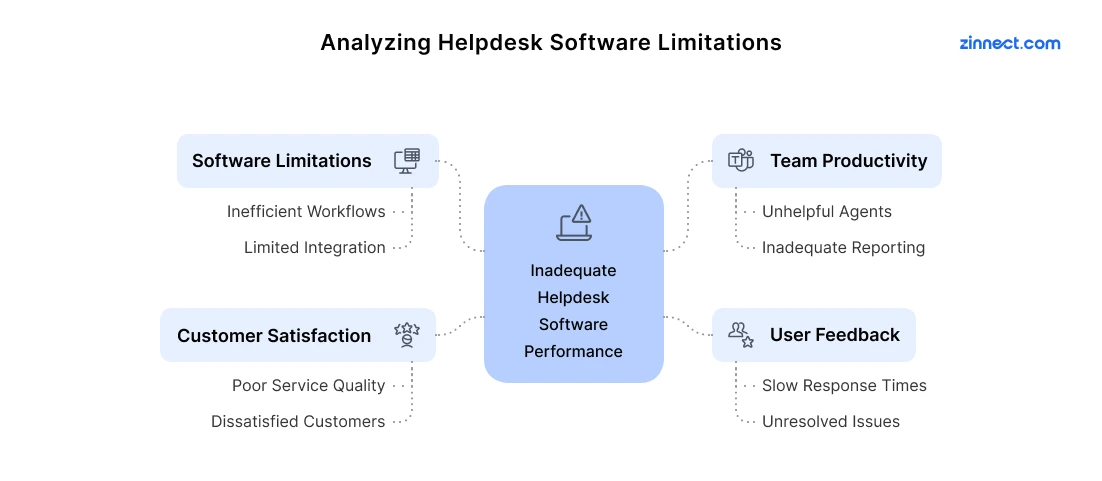Should You Swap Your Helpdesk Software for an AI Helpdesk?

Are you tired of dealing with the limitations of traditional helpdesk software? You’re not alone. As customer expectations continue to soar, it’s becoming increasingly clear that old-school helpdesks just can’t keep up. With AI helpdesks, you can automate routine tasks, speed up response times, and deliver a more personalized experience for your customers. But is making the switch worth it? Let’s explore the benefits and challenges of trading in your traditional helpdesk for an AI-powered one.
Key Takeaways
- AI helpdesks automate routine tasks, leading to cost savings and enhanced operational efficiency, making them a viable alternative to traditional helpdesks.
- Integrating an AI helpdesk can be challenging, but evaluating resources and addressing team concerns can ensure a smooth transition and improved customer satisfaction.
- AI helpdesks provide valuable customer insights through predictive analytics, enabling personalized support experiences and increased customer loyalty.
- Balancing automation with human interaction is crucial, as AI excels at handling routine inquiries, while human agents focus on complex, emotionally charged issues.
- Continuous monitoring and adaptation to customer needs are essential to ensure the AI helpdesk remains effective, efficient, and aligned with evolving customer expectations.
The Evolution of Customer Support: Why Traditional Helpdesks Are Failing
As customer expectations continue to rise, traditional helpdesks are struggling to keep up, and it’s becoming increasingly clear that they’re no longer cutting it. You’re likely feeling the pressure to meet these expectations, but your current helpdesk is holding you back. It’s not scalable, and you’re constantly playing catch-up to resolve issues. The result is frustrated customers and a negative brand reputation. You need a solution that can keep pace with growing customer expectations and provide support scalability. The question is, can your traditional helpdesk evolve to meet these demands, or is it time to contemplate an alternative?
AI Helpdesks: The Promise of Automation and Efficiency

With customer expectations rapidly outpacing traditional helpdesks, you’re likely searching for a solution that can efficiently scale to meet the demands of your growing customer base. AI helpdesks promise to deliver just that. By automating routine tasks, you’ll open up significant cost savings and free up your team to focus on high-value tasks. Intelligent routing guarantees that complex issues are directed to the right agents, while predictive analytics provides valuable customer insights. Workflow optimization and task delegation streamline your operations, leading to a better user experience. With AI efficiency, you can achieve service scalability without sacrificing quality. By leveraging these automation benefits, you’ll be better equipped to meet the evolving needs of your customers.
Key Differences Between Traditional and AI-Powered Helpdesks
You’ve likely worked with traditional helpdesks, where agents manually sort through tickets, respond to queries, and escalate complex issues. This process can be time-consuming and prone to human error. In contrast, AI-powered helpdesks automate many of these tasks, freeing up agents to focus on more complex, high-value tasks. One of the key benefits of AI helpdesks is their ability to provide a seamless user experience through automation. For instance, AI can automatically route tickets to the right agents, respond to frequent queries, and even offer personalized solutions. This results in faster response times, reduced wait times, and increased customer satisfaction. Overall, AI helpdesks offer a more efficient and effective way to manage customer support, leading to significant automation benefits and a better user experience.
The Benefits of AI Helpdesks: Faster Resolution Times and Happier Customers
By leveraging AI-powered automation, helpdesks can markedly reduce resolution times, which is essential in today’s fast-paced digital landscape where customers expect swift responses. With AI helpdesks, you can provide customers with faster responses, leading to increased customer satisfaction. Here’s how:
- Faster ticket routing: AI-powered helpdesks can automatically route tickets to the right agents, reducing the time it takes to resolve issues.
- Automated resolutions: AI can resolve simple issues without human intervention, freeing up agents to focus on complex problems.
- Proactive issue detection: AI-powered helpdesks can detect potential issues before they become major problems, allowing you to take proactive measures to prevent customer frustration.
The Dark Side of AI Helpdesks: Integration Challenges and Data Quality Issues
While AI helpdesks boast impressive benefits, they’re not immune to challenges that can hinder their effectiveness. One major hurdle you’ll face is integration hurdles. AI helpdesks often require extensive setup and integration with your existing systems, which can be time-consuming and costly. You’ll need to guarantee seamless data exchange between your AI helpdesk and other tools, such as CRM or ticketing systems. Additionally, data quality issues can arise if your AI helpdesk doesn’t receive accurate and complete information from these integrated systems. This can lead to poor data integrity, affecting the overall performance of your AI helpdesk. You’ll need to carefully evaluate these challenges and consider the resources needed to overcome them before making the switch to an AI helpdesk.
Understanding Your Customer Support Needs: A Guide to Making the Right Choice
How will you know if an AI helpdesk is the right fit for your customer support needs? Start by taking a closer look at your current support operations. Ask yourself: what are your biggest pain points? Where do you struggle to provide timely and effective support?
Consider the following factors when evaluating your customer support needs:
- Are you experiencing rapid growth and need support scalability to keep up with demand?
- Are you struggling to gather and act on customer feedback in a timely manner?
- Are your support agents bogged down with repetitive tasks, taking away from more complex issues that require human expertise?
Assessing Your Current Helpdesk Software: Is It Time for a Change?
What’s holding your current helpdesk software back from meeting your evolving customer support needs? Take a closer look at its current software limitations. Are you struggling with inefficient workflows, inadequate reporting, or limited integration capabilities? Evaluating user feedback can also provide valuable insights. Are customers complaining about slow response times, unhelpful agents, or unresolved issues? Identify the pain points that are impacting your support team’s productivity and customer satisfaction. Be honest with yourself – is your current software holding you back from providing the level of service your customers expect? If so, it may be time to reflect on an AI-powered helpdesk that can help you overcome these limitations and take your customer support to the next level.

The Role of Human Support Agents in an AI-Powered Helpdesk
You’ve identified the limitations of your current helpdesk software and are considering an AI-powered solution. As you weigh the benefits of automation, it’s important to recognize the vital role human support agents will still play in your new helpdesk setup.
- Human empathy is vital in resolving complex, emotionally charged customer issues that automation can’t replicate.
- Support synergy is achieved through agent collaboration, where AI handles routine tasks, freeing humans to focus on high-value, creative problem-solving.
- Automation limits are evident in situations requiring nuanced understanding, such as exceptions to policies or one-off customer requests, where human judgment and discretion are necessary to maintain customer trust.
Can AI Helpdesks Really Provide Personalized Support Experiences?
Can AI helpdesks truly deliver on the promise of personalized support experiences, or do they inevitably fall short? You might wonder if AI-powered helpdesks can genuinely understand your customers’ unique needs and preferences. The answer lies in their ability to employ effective personalization strategies. By leveraging customer data and behavior patterns, AI helpdesks can tailor support interactions to individual customers, fostering deeper customer engagement. For instance, AI can analyze customer interactions to identify common pain points and proactively offer targeted solutions. This not only enhances the support experience but also increases customer loyalty and retention. By harnessing the power of AI, you can create support experiences that feel truly personalized and empathetic.
Measuring the Success of an AI Helpdesk: Key Performance Indicators
As you implement an AI helpdesk, it’s vital to track its performance to guarantee it’s meeting your customers’ evolving needs and expectations. You need to define and measure key performance indicators (KPIs) to make sure the AI helpdesk is delivering the desired outcomes.
Some essential success metrics to monitor include:
- First Response Time (FRT): The time taken to respond to customer inquiries, which greatly impacts customer satisfaction.
- Resolution Rate: The percentage of issues resolved on the first interaction, indicating the AI helpdesk’s effectiveness.
- Customer Satisfaction (CSAT): A measure of how happy customers are with the support experience, which can be tracked through surveys or feedback forms.
Overcoming the Fear of Change: How to Get Your Team on Board With AI
Implementing an AI helpdesk can be a significant shift for your team, and it’s natural for them to feel apprehensive about the changes it brings. Effective change management is essential to guarantee a smooth shift. Start by communicating the reasons behind the change and highlighting the benefits of an AI helpdesk.
Key Metrics You Should Use to Calculate AI Helpdesk ROI
Measuring the following parameters and comparing them enables you to calculate the return on investment for AI vs traditional helpdesks.
| Step | Description | Responsibility |
|---|---|---|
| 1 | Communicate the need for change | Team Lead |
| 2 | Provide training on AI helpdesk | Training Officer |
| 3 | Address concerns and questions | Team Lead |
| 4 | Gradually roll out AI helpdesk | IT Department |
| 5 | Monitor progress and feedback | Team Lead |
The Importance of Continuous Training and Improvement in AI Helpdesks
Once you’ve successfully rolled out your AI helpdesk, you might think the hard work is behind you, but that’s not entirely true. You’ll need to continuously train and improve your AI system to guarantee it remains effective and efficient. This involves implementing effective training methodologies that adapt to your customers’ evolving needs and preferences.
To achieve this, you should:
- Establish feedback loops that capture customer and agent feedback to refine your AI’s decision-making processes
- Regularly update your AI’s knowledge base to reflect changes in your products, services, or policies
- Monitor key performance indicators (KPIs) to identify areas for improvement and optimize your AI’s performance
Balancing Automation With Human Touch: Finding the Sweet Spot
While AI helpdesks excel at handling routine inquiries and freeing up agents to focus on complex issues, they can sometimes lack the empathy and emotional intelligence that customers crave in their interactions. You need to strike a balance between automation and human touch to guarantee customer satisfaction. Automated responses can efficiently address common questions, but human interaction is essential for resolving emotional or complex issues. By combining technology acceptance with agent collaboration, you can provide personalized service and enhance user experience. Finding the sweet spot between support efficiency and human interaction will lead to increased customer satisfaction and loyalty.
Scaling Your Customer Support With AI Helpdesks
As you’ve mastered the art of balancing automation with human touch, you’re now poised to take your customer support to the next level by scaling it with AI helpdesks. With scalable solutions, you can handle a growing volume of customer inquiries without sacrificing quality or increasing costs. AI helpdesks enable you to:
- Automate routine tasks, freeing up human agents to focus on complex, high-value issues
- Provide 24/7 support, ensuring that customers receive timely responses and resolutions
- Analyze customer interactions to identify trends and opportunities for improving customer engagement
The Future of Customer Support: What’s Next for AI Helpdesks?
The rapid evolution of AI helpdesks has revolutionized customer support, and you’re likely wondering what’s on the horizon. As AI advancements continue, you can expect even more personalized support experiences tailored to individual customers’ needs. Automation trends will drive efficiency, freeing human agents to focus on complex issues. Future innovations will integrate AI with other technologies, like chatbots and virtual assistants, to create seamless user experiences. To meet rising customer expectations, AI helpdesks will need to evolve, incorporating new tech integrations and support personalization features. The future of customer support is about service evolution, and AI helpdesks are poised to lead the way.